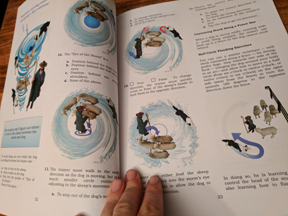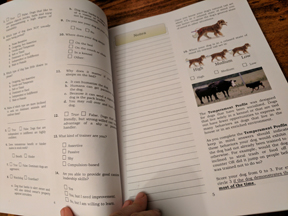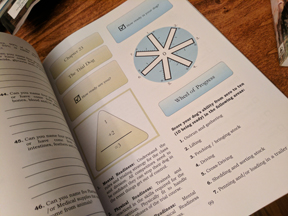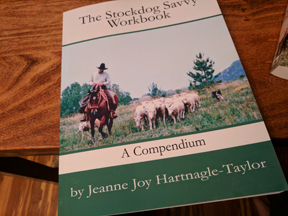I think this is true for most Aussie people, but Jeanne Joy Hartnagle-Taylor is my first Aussie mentor. It started because her book (All About Aussies) was the first one I bought, even before I had a dog, and it shaped my perception of the breed. Her family’s kennel name is pretty much known by every Aussie person for this reason, and the photos in those books really set a “type” for me about what these dogs should be.
Moreover, her entire family is very academic and literary in their approaches to things, which has always appealed to me. In stockdogs, there are the common sense people and there are the analytical people, and I’ve always fit in the latter class. My brain takes over most of the time and makes me question my instincts. It makes being a stockdog trainer and handler a challenge, but one that truly builds character and teaches humility and self-improvement every time I step into the arena or field.
When I saw her announcement that The Workbook was available on her feed, I jumped at the chance to get my hands on it for a review. I’ve long battled with finding an objective way to evaluate my process with my dog that wasn’t all thinking and all feeling, and I had hoped that Hartnagle-Taylor’s book would be the solution I’ve been yearning for.
Upon first cracking it open, I was pretty excited to see little quizzes in there and charts and really interesting graphics and was excited to take the time to dive into it and see what I could get from it with my in-progress dog.
Organized in a logical way – she approaches teaching you how to understand your dog in a nonjudgemental and open-ended way and then proceeds through different training stages for the beginning handler to the trialer, ending with details on the different stock and stockdog programs. Probably the best thing about this book is that stockdog trainers generally approach things in a traditional schooling method that’s “give over to the student” rather than make the student draw conclusions. This book changes that – with tests that force a student to guess, then check their work, it builds a natural confidence in up and coming stockdog trainers to learn to draw conclusions for themselves and ask questions rather than experience a one-way relationship with their trainer. I think teaching in this way can continue to progress students and training methods forward and make people less reliable on trainers in general if they’re able to think this way about stockdogs and stock moving.
I have to say that as someone who’s got a bit more than 15+ years of dabbling in the stockdog wading pool under her belt, I have a really hard time saying how effective all of this is . . . while it was fun, I didn’t feel compelled to do all the quizzes and take it step by step because I knew most everything and found myself skimming for the gems that I could add to my box of tools. I feel that the book itself is probably much better suited to someone just starting out, and it’s best suited, I think, to a clinic application.

Really cool graphics illustrating a point in a new way for me.
Here’s why – many of the quizzes in the book encourage some self-teaching, but things like self identifying what kind of handler you are without any instruction to the fact made me wonder if I was missing something. Throughout the book, at the end of each chapter, she has a checklist of potential problems you might be running into, and then some self-guided questions to run through to see if you can self-correct. But having been in that position a lot, I didn’t feel that I had a complete picture about how to fix the issues I’d identified and ended up pulling out her other book, Stockdog Savvy to check that it wasn’t meant to be a companion resource (as there are lots of issues identified with potential fixes within that.). Based on its organization and its lack of referential hints, I’d say it probably isn’t, and that’s a shame. I’d definitely recommend picking up both books in conjunction if you’re interested because you’ll need them to really get the most out of the compendium.

An example of the quizzes, note spaces, and information layout.
She also has a lot of really good material in the book that I think gets glossed over and needs further instruction if it was meant for standalone use without a clinician or supplement. For example, early in the book, on page 5 – there’s a wonderful diagram illustrating different tailsets (with a faded out tail and a bobtail in the same image). She says, “Once you now your dog’s natural tail set when it’s in a relaxed state of mine, you can better recognize the dog’s general state of mind in other situations,” which is simple enough, but I think misses a really instructional point – that you look for that relaxed tail pretty much all the time in stockdogging before progressing on or asking for something out of your dog. It gets the blurb here but then it just isn’t put into context to be useful to someone later and that’s a shame.
I LOVED the temperament profile. As I filled it out, I found I got a really nice objective view of my dog and it underscored something I’d been hesitant to believe – that she has very low avoidance drive (flight) and that when she quits me, she’s being stubborn. If I owned that, I probably wouldn’t have been so unsure in our training process about how to handle it.

The Wheel – what a cool tool!
Other little gems throughout included the whistle command recommendations in a clear and easy way – I haven’t seen it anywhere else laid out so easily and usefully and that’s what’s stopped me from adding it to my tool box. I loved the wheel of progress on page 99 in the trialing section – but the lack of explanation of how to use it makes me wonder . . . when do you put your dog in a trial, when it’s 10 out of 10? Having a guide for each type of trial and level would make this thing SO much more useful!
The actual training parts really have a beautiful, simple way of explaining step by step goals of each behavior, but as I said, when you get to the end, she asks you to check off issues you see. The questions run down whether it’s personality, instinct, training, you, etc . . . but no clue how to approach it if you don’t have the experience to make use of those questions – so while I love how she encourages self-reliance, the lack of advice once you identify the issue highlights a clear revision point for the next edition.
I also love the specifics of reading and handling stock – charts of reading cattle head positions to determine what the cow is going to do, asking where the draw is based off some pictures.
An eBook version of this would also be amazing as you could print it out and use the charts as a training journal without the bulk of the book for multiple dogs, or offering it eBook style for multiple licenses for clinics . . . the potential is endless.
All in all, the compendium really inspired me.
- I think every stockdog instructor should take a look at it and see if it’s a tool they can use with their clients – where they can fill in the gaps I felt were there. I think as a teaching tool, it could really improve the quality of instruction many trainers give their clients and encourage that back and forth that is essential to ending up with independent and capable students.
- Beginning stockdog people without regular access to a trainer will also really find this useful, but again, I’d pick up her other book as well. Using this as a lead and the book itself as a supplement should provide enough guidance to get people going in the right direction without getting lost in the headiness of a the Stockdog Savvy book as a book.
And finally, the real inspiration for me is that I want to take parts of this and expand on it for my own self . . . make individual training records for my dogs, break up the parts and expand on things I would like to see . . . and find a new stockdog handler to test this compendium on.



